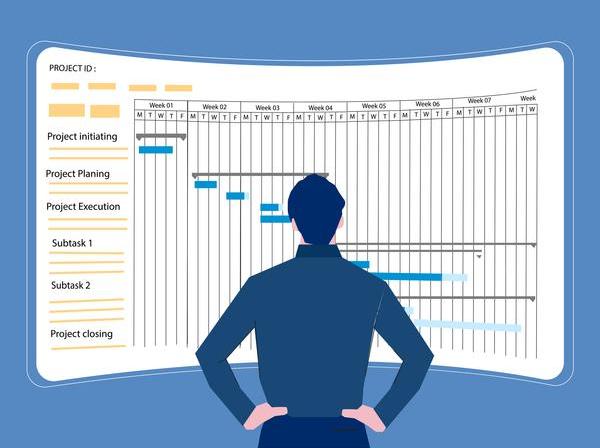The world of work is changing at an increasingly rapid pace and project management is no exception. It is becoming more complex, requiring new tools to tackle new, as well as some old, challenges.
AI is already transforming how work is done in all areas of business, so what about AI in project management? Why should we use it? What are the benefits and what do we need to be careful of?
When we look at the statistic that just 35 per cent of projects today are completed successfully, according to the IT research advisory firm the Standish Group, it is clear that we need a solution.
AI provides that solution and according to the research and advisory company Gartner, by 2030, up to 80 per cent of project management tasks could be run by AI, powered by big data, machine learning (ML), and natural language processing.
So it’s not a question of IF you want to use it, but how you can best use it, and what opportunities it can provide for your business.
Let’s look first at the advantages it offers.

The Benefits of AI in Project Management
-
Automation: By using virtual assistants, AI can automate administrative, repetitive and low-value tasks and processes such as scheduling meetings, creating reports for managers, or sending email reminders regarding a project's deadline. Chatbots can also handle routine project inquiries, which frees up project managers' time to focus on more strategic tasks. A case study of car manufacturer Jaguar Land Rover shows the company made cost savings of more than £1m, as well as improving compliance, by automating more than 160 finance processes using AI and Robotic Process Automation (RPA). These processes included reporting, audits, travel expenses and purchasing.
-
AI can help your organisation to select, prioritise and implement projects more successfully. When the correct data is available, Machine Learning (ML) can detect patterns that humans can’t, or can’t easily anyway, and can make more accurate predictions than those of mere mortals…
-
Risk management: New applications use big data and ML to help leaders and project managers assess risks. These tools can rank risks identified by humans and suggest how to mitigate them. They can also help adjust the plans to avoid certain types of risks and suggest contingency plans. Project managers can also connect a cloud-based Project Portfolio Management (PPM) tool and generative AI to produce a risk log. They do this by explaining the context of the project and requesting a certain number of risks, which are based on data not just from the project managers themselves, but on combined data from the internet as well. Of course, certain risks can and should be added manually, and AI should support, not replace, insights from project leaders and managers, but an AI generated risk is a good starting point.
-
AI tools can help keep projects on track, reducing the need for manual updates, which are time-consuming and repetitive. For example, these tools can automatically update project timelines based on progress data and can generate status reports by analysing updates from the project team.
-
Virtual Project Assistants are a tool that project leaders can leverage to increase project success and enhance team dynamics. These assistants gather data on things such as past projects, project completion rates, employee skills and available equipment. They can then assign tasks to the team members who have the skills to complete them more quickly and accurately allocate the time needed to complete the work. They can also suggest postponing a project if the equipment is not available. This reduces errors and saves project managers’ time and effort that they could be spending to create more value. It is crucial however, if VAs are to be accepted by human teams, to properly define roles and expectations, outlining their responsibilities, the scope of tasks and how their work fits into wider team objectives. Human teams need to be able to clearly see how the VAs contribute to the team’s success in order to feel a sense of shared purpose. Involving VAs in team meetings, celebrating their achievements and encouraging informal interactions can help foster a culture of inclusion.
-
Testing: Big projects involve project managers testing multiple systems and types of software. Automated system testing solutions for software projects mean defects can be detected and corrected early. This saves time and ensures bug-free and user-friendly solutions.
-
Cost estimating: Forbes cites a successful case study in which a financial grid within the Project Portfolio Management (PPM) tool was connected to ChatGPT. Rather than the traditional way of users manually inputting expected costs into each cell based on the cost category and time frame, ChatGPT was able to suggest and distribute the full cost based on an S-curve — a mathematical graph that shows the progress of a project over time. Project managers were also able to customise the experience to accommodate different time frames, from years to quarters or months, depending on company need. This undoubtedly saved a lot of time manually drafting the information, but it is also important to recognise that AI-generated data should always be considered a proposal only. Whether this method leads to accurate financial forecasting, is dependent on the company sharing enough detailed data.
-
Cost reduction: AI can reduce costs not only by reducing errors but also by taking on repetitive tasks that people would otherwise need to be paid to do.
-
Better decision-making: AI systems can process huge volumes of information that humans just couldn’t handle and they then use this information to help managers make more informed decisions. They can analyse how your teams perform and what difficulties they usually face and can alert you if your project is falling behind schedule.

Challenges of Implementing AI in Project Management
An AI transformation, like any other kind, poses challenges as well as offering great benefits. Let’s look at some of these:
-
Ethical issues and biases: AI systems are trained using existing data that may contain biases. This means an AI-powered project could assign tasks to team members based solely on gender, race, and other biased criteria, negatively affecting your team’s performance and, therefore, the project outcome. It is therefore essential to use qualitative and diverse data to train your AI and to have a set of ethical guidelines as well as regular audits.
-
Transparency and fairness: Transparency in the way you use your AI systems is vital. You need to explain how AI makes decisions and let people intervene when needed to prevent ethical issues from arising.
-
Data security: Data from project plans, records, financial documents and collaboration tools can be susceptible to breaches and other security risks that can jeopardise your business's reputation. Your project management tools may also be hacked in order to access sensitive information. It is therefore vital that you implement strong data encryption and anonymisation with strict access controls. You must also ensure you comply with regulatory laws and have a tech support and legal team that can step in if necessary.
-
Privacy: Guidelines and policies to safeguard privacy must be drawn up when collecting and analysing personal or sensitive data to ensure that AI is being used responsibly.
-
Integration: You will need to check that your AI tool is compatible with your project management system, especially if you have been using older software. Your current systems will need to be able to deal with the amount of data that AI generates and support the increased workload it will generate.
-
Preparing your people: Any AI transformation needs available and properly managed data, but no AI transformation will be successful if you don’t prepare your people for the change. Your teams need to be willing to move out of their traditional comfort zones and radically change how they manage their projects. You will also need to train them how to use any new software.
-
Letting go of old habits: You need to be prepared to let go of your old project management habits, such as monthly progress reports.
-
Making room for mistakes: Just as with a human employee, you need to allow your new technology to make mistakes as it learns to perform better for your organisation.
-
Potential job displacement: AI tools will automate many tasks, meaning some job roles may no longer be needed.
-
Patience! Senior leaders need to be prepared to wait from several months to one year to start seeing the benefits of this automation.

Final Thoughts
AI in project management can be a godsend. It can take those mundane tasks off your hands, improving efficiency and freeing up your team for work that will generate more value. It is a tool that should be used to empower people to think, to be creative and to collaborate with others in an agile way.
It can pre-empt problems and offer solutions before they arise and give you an undeniable competitive advantage in any industry.
But…it’s vital you ensure that AI solutions are tailored to meet specific organisational needs and that AI tools are constantly monitored and their work critically assessed. AI should act as a co-pilot and should never be a replacement for human intelligence.
It’s also of paramount importance that you prepare your company and your people for the use of AI by investing in training and establishing a culture of continuous learning.
Further reading: Generative AI : Disrupting Traditional Marketing (agilebusiness.org)
Please note blogs reflect the opinions of their authors and do not necessarily reflect the recommendations or guidance of the Agile Business Consortium.
